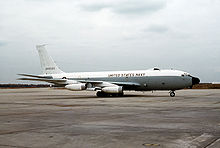Boeing NC-135
| NC-135 / NKC-135 | |
|---|---|
 A USAF NKC-135A Airborne Laser Lab |
|
| Type: | Test aircraft / reconnaissance aircraft |
| Design country: | |
| Manufacturer: | |
| Commissioning: |
1963 |
| Number of pieces: |
5 |
The Boeing NC-135 and NKC-135 are special versions of the Boeing C-135 "Stratolifter" and the Boeing KC-135 "Stratotanker" that have been modified for various programs.
history
Readiness Program
In support of the U.S. Test Readiness Program initiated in response to the Limited Test Ban Treaty (LTBT) of 1963, Sandia National Laboratories configured three NC-135 aircraft as flying laboratories to aid in atmospheric testing of nuclear weapons. These planes were stationed at Kirtland Air Force Base. Work began in 1963 and the aircraft remained in service until 1976, mainly for Sandia National Laboratories, Los Alamos National Laboratory, and Lawrence Livermore National Laboratory . The Atomic Energy Commission (AEC) retained oversight of the NC-135 test flight aircraft. After 1976 the aircraft flew for the Air Force Weapons Laboratory.
Airborne astronomy missions
During the flight simulations for the Test Readiness Program, the science teams assigned to the NC-135 aircraft realized that their flight labs could be effectively used to study solar eclipses, as well as cosmic rays entering the atmosphere and the effects of magnetic fields in the ionosphere . Program scientists requested the AEC to allow a program within a program to use the aircraft for such scientific research. The petition was approved and research continued until 1975.
The first solar eclipse mission took place in 1965 from Pago Pago International Airport . Together with several other research aircraft, one of the NC-135s managed to fly within the solar eclipse totality for 160 seconds and provide valuable scientific data. Solar eclipse missions were also flown in 1970, 1972, 1973, 1979 and 1980.
Big Crow
Big Crow is the name of the two test aircraft NKC-135 (55-3132 and 63-8050), which have been heavily modified for electronic warfare. These aircraft were also used as target simulators for flight tests with the Boeing YAL-1 Airborne Laser. On March 15, 2007, the YAL-1 successfully shot this laser in flight and hit its target. The target was the test aircraft NKC-135E Big Crow 1, which was specially modified with a "shield" target on the fuselage. The test confirmed the system's ability to track an airborne target and measure and compensate for atmospheric distortions. The "Big Crow" planes were also used as telemetry transmitters in connection with the Western Launch and Test Range takeoffs from Vandenberg Air Force Base , California. Since 2008, the 55-3132 and 63-8050 have been taken out of service and stored at AMARG (Davis-Monthan AFB), Tucson, AZ.
Other versions
One aircraft, with serial number 61-2666, was modified to an NC-135W to test systems and equipment used on RC-135V and W Rivet Joint reconnaissance aircraft.
From 1975 to 1984, the US used an NKC-135 for its Airborne Laser Lab program. The modified NKC-135A carried a 10.6 micrometer carbon dioxide laser. The tests included successful interception of small air-to-air missiles (such as the AIM-9 Sidewinder ) and drones . Despite the combat potential of the system, it was kept strictly experimental. However, the Scud threat during the Second Gulf War rekindled interest in an airborne laser system, leading to the Boeing YAL-1.
The 55-3123 - originally built as the KC-135A - was converted into the NKC-135 Airborne Laser Lab and has been on display at the National Museum of the United States Air Force in Dayton , Ohio since 1984 . In August 2011, it was removed from the museum's air park to make way for the museum's Lockheed C-5 . The aircraft is currently in storage.
Users
Technical specifications
| Parameter | Data |
|---|---|
| Type | Test aircraft / reconnaissance aircraft |
| length | 41.53 m |
| span | 39.88 m |
| Wing area | 226 m² |
| height | 12.70 m |
| Empty mass | 44,663 kg |
| Max. Takeoff mass | 146,000 kg |
| Top speed | 933 km / h |
| Max. Altitude | 15,200 m |
| Max. Range | 5550 km |
| Rate of climb | 1490 m / min |
| drive | 4 × (R / T) CFM-International engines CFM-56 Turbofan, 96 kN thrust per engine or 80 kN in the old version |
Web links
Individual evidence
- ↑ Readiness Program (PDF) Sandia National Laboratories. Archived from the original on February 12, 2006. Retrieved March 22, 2007.
- ↑ a b c Barb Mulkin: In Flight: The Story of Los Alamos Eclipse Missions (PDF) In: Los Alamos Science . Los Alamos National Laboriatories. Retrieved March 22, 2007.
- ↑ Wendy Dolci: Milestones in Airbornce Astronomy: From the 1920s to the Present (PDF) American Institute of Aeronautics and Astronautics. 1997. Archived from the original on March 30, 2005. Retrieved March 22, 2007.
- ↑ RDT & E, DW / 04 Advanced Component Development and Prototypes (PDF) In: Missile Defense Agency (MDA) Exhibit R-2 RDT & E Budget Item Justification . Missile Defense Agency. February 2007. Retrieved March 22, 2007.
- ↑ Eric M. Grill: Airborne Laser fires tracking laser, hits target . Aerotech News and Review , March 23, 2007, vol 22, issue 8
- ↑ Justin Ray: Delta 2 rocket launch of GeoEye craft postponed . Spaceflight Now. August 12, 2008.
- ↑ HNL RareBirds . Retrieved July 9, 2015.
- ↑ NKC135B & E 63-8050 / 55-3132 USAF . Retrieved July 18, 2015.
- ↑ DoD 4120.15L Model Designations of Military Aerospace Vehicles
- ↑ DOD 4120.15-L - Addendum . In: designation-systems.net .
- ^ John Pike: Airborne Laser Laboratory . In: globalsecurity.org .
- ↑ [1] HIGH ENERGY LASER WEAPONS
- ↑ BOEING NKC-135A STRATOTANKER (AIRBORNE LASER LAB) . Archived from the original on July 22, 2015. Retrieved July 9, 2017.

